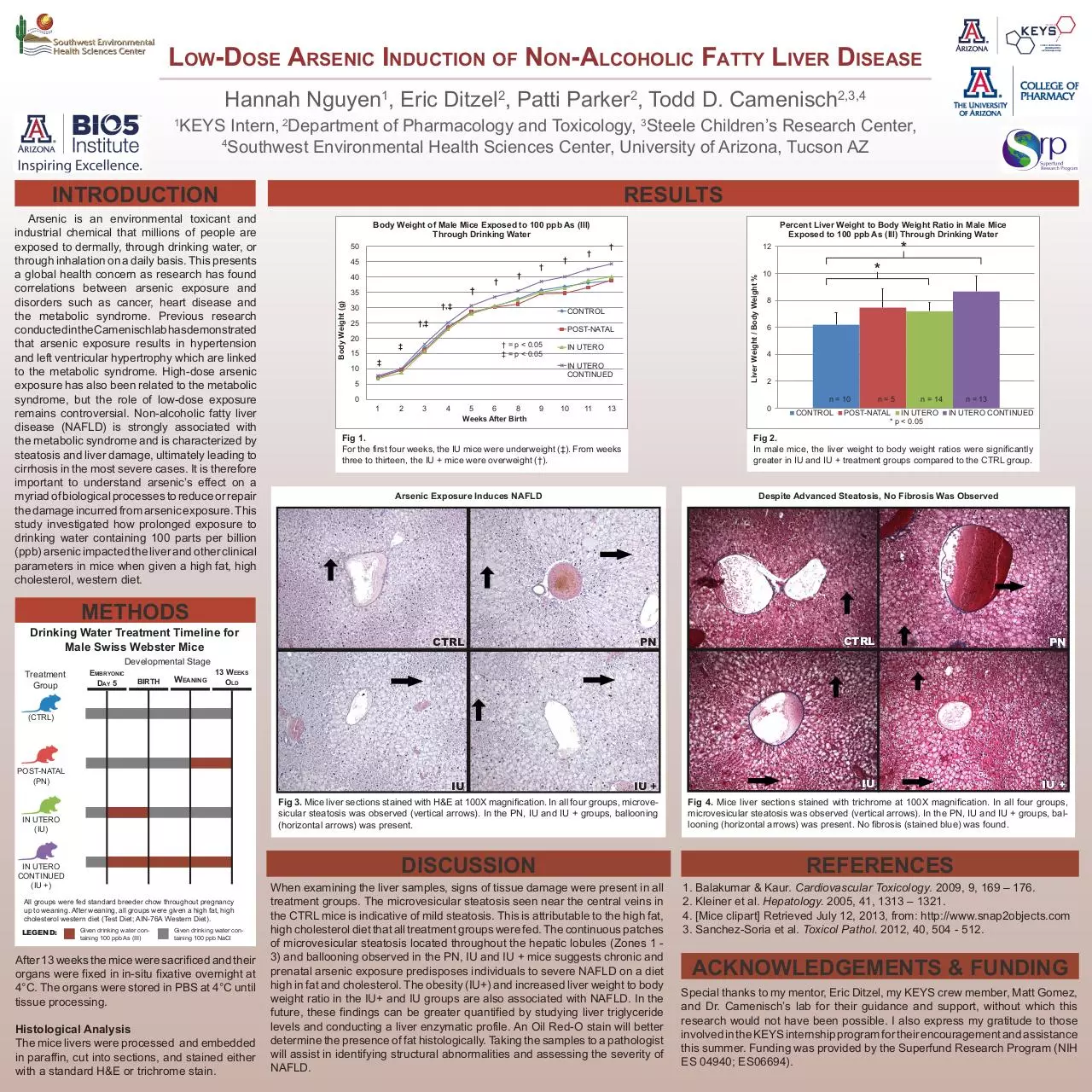arsenic poster 3 (PDF)
File information
This PDF 1.4 document has been generated by Adobe InDesign CS2 (4.0) / Adobe PDF Library 7.0, and has been sent on pdf-archive.com on 10/01/2016 at 06:40, from IP address 128.12.x.x.
The current document download page has been viewed 462 times.
File size: 11.6 MB (1 page).
Privacy: public file

File preview
Low-Dose Arsenic Induction of Non-Alcoholic Fatty Liver Disease
Hannah Nguyen , Eric Ditzel , Patti Parker , Todd D. Camenisch
1
2
2,3,4
KEYS Intern, Department of Pharmacology and Toxicology, Steele Children’s Research Center,
4
Southwest Environmental Health Sciences Center, University of Arizona, Tucson AZ
2
3
Introduction
Body Weight of Male Mice Exposed to 100 ppb As (III)
Through Drinking Water
50
45
40
†
35
Body Weight (g)
Arsenic is an environmental toxicant and
industrial chemical that millions of people are
exposed to dermally, through drinking water, or
through inhalation on a daily basis. This presents
a global health concern as research has found
correlations between arsenic exposure and
disorders such as cancer, heart disease and
the metabolic syndrome. Previous research
conducted in the Camenisch lab has demonstrated
that arsenic exposure results in hypertension
and left ventricular hypertrophy which are linked
to the metabolic syndrome. High-dose arsenic
exposure has also been related to the metabolic
syndrome, but the role of low-dose exposure
remains controversial. Non-alcoholic fatty liver
disease (NAFLD) is strongly associated with
the metabolic syndrome and is characterized by
steatosis and liver damage, ultimately leading to
cirrhosis in the most severe cases. It is therefore
important to understand arsenic’s effect on a
myriad of biological processes to reduce or repair
the damage incurred from arsenic exposure. This
study investigated how prolonged exposure to
drinking water containing 100 parts per billion
(ppb) arsenic impacted the liver and other clinical
parameters in mice when given a high fat, high
cholesterol, western diet.
results
†,‡
30
20
10
POST-NATAL
† = p < 0.05
‡ = p < 0.05
‡
‡
0
1
IN UTERO
IN UTERO
CONTINUED
5
2
3
4
5
6
8
Weeks After Birth
9
10
11
*
12
†
CONTROL
†,‡
25
15
†
†
†
†
†
Percent Liver Weight to Body Weight Ratio in Male Mice
Exposed to 100 ppb As (III) Through Drinking Water
Liver Weight / Body Weight %
1
2
8
6
4
2
0
13
Fig 1.
For the first four weeks, the IU mice were underweight (‡). From weeks
three to thirteen, the IU + mice were overweight (†).
*
10
n = 10
CONTROL
n=5
n = 14
POST-NATAL IN UTERO
* p < 0.05
n = 13
IN UTERO CONTINUED
Fig 2.
In male mice, the liver weight to body weight ratios were significantly
greater in IU and IU + treatment groups compared to the CTRL group.
Arsenic Exposure Induces NAFLD
Despite Advanced Steatosis, No Fibrosis Was Observed
METHODS
Drinking Water Treatment Timeline for
Male Swiss Webster Mice
Developmental Stage
Treatment
Group
Embryonic
Day 5
birth
Weaning
CTRL
PN
CTRL
PN
IU
IU +
IU
IU +
13 Weeks
Old
CONTROL
(CTRL)
POST-NATAL
(PN)
IN UTERO
(IU)
IN UTERO
CONTINUED
(IU +)
All groups were fed standard breeder chow throughout pregnancy
up to weaning. After weaning, all groups were given a high fat, high
cholesterol western diet (Test Diet; AIN-76A Western Diet).
LEGEND:
Given drinking water containing 100 ppb As (III)
Given drinking water containing 100 ppb NaCl
After 13 weeks the mice were sacrificed and their
organs were fixed in in-situ fixative overnight at
4°C. The organs were stored in PBS at 4°C until
tissue processing.
Histological Analysis
The mice livers were processed and embedded
in paraffin, cut into sections, and stained either
with a standard H&E or trichrome stain.
Fig 3. Mice liver sections stained with H&E at 100X magnification. In all four groups, microvesicular steatosis was observed (vertical arrows). In the PN, IU and IU + groups, ballooning
(horizontal arrows) was present.
Fig 4. Mice liver sections stained with trichrome at 100X magnification. In all four groups,
microvesicular steatosis was observed (vertical arrows). In the PN, IU and IU + groups, ballooning (horizontal arrows) was present. No fibrosis (stained blue) was found.
discussion
REFERENCEs
When examining the liver samples, signs of tissue damage were present in all
treatment groups. The microvesicular steatosis seen near the central veins in
the CTRL mice is indicative of mild steatosis. This is attributable to the high fat,
high cholesterol diet that all treatment groups were fed. The continuous patches
of microvesicular steatosis located throughout the hepatic lobules (Zones 1 3) and ballooning observed in the PN, IU and IU + mice suggests chronic and
prenatal arsenic exposure predisposes individuals to severe NAFLD on a diet
high in fat and cholesterol. The obesity (IU+) and increased liver weight to body
weight ratio in the IU+ and IU groups are also associated with NAFLD. In the
future, these findings can be greater quantified by studying liver triglyceride
levels and conducting a liver enzymatic profile. An Oil Red-O stain will better
determine the presence of fat histologically. Taking the samples to a pathologist
will assist in identifying structural abnormalities and assessing the severity of
NAFLD.
1. Balakumar & Kaur. Cardiovascular Toxicology. 2009, 9, 169 – 176.
2. Kleiner et al. Hepatology. 2005, 41, 1313 – 1321.
4. [Mice clipart] Retrieved July 12, 2013, from: http://www.snap2objects.com
3. Sanchez-Soria et al. Toxicol Pathol. 2012, 40, 504 - 512.
acknowledgements & FundING
Special thanks to my mentor, Eric Ditzel, my KEYS crew member, Matt Gomez,
and Dr. Camenisch’s lab for their guidance and support, without which this
research would not have been possible. I also express my gratitude to those
involved in the KEYS internship program for their encouragement and assistance
this summer. Funding was provided by the Superfund Research Program (NIH
ES 04940; ES06694).
Download arsenic poster 3
arsenic poster 3.pdf (PDF, 11.6 MB)
Download PDF
Share this file on social networks
Link to this page
Permanent link
Use the permanent link to the download page to share your document on Facebook, Twitter, LinkedIn, or directly with a contact by e-Mail, Messenger, Whatsapp, Line..
Short link
Use the short link to share your document on Twitter or by text message (SMS)
HTML Code
Copy the following HTML code to share your document on a Website or Blog
QR Code to this page

This file has been shared publicly by a user of PDF Archive.
Document ID: 0000331000.